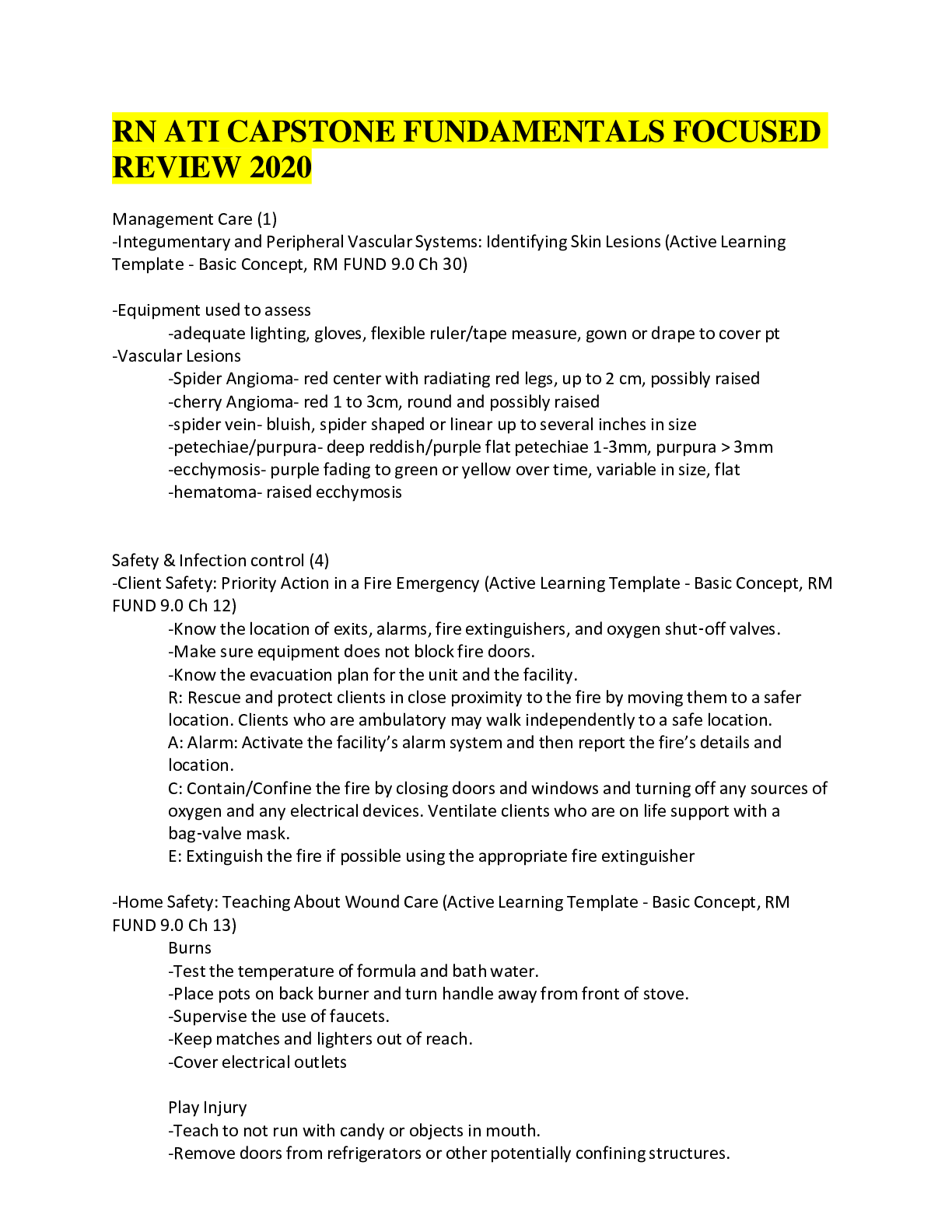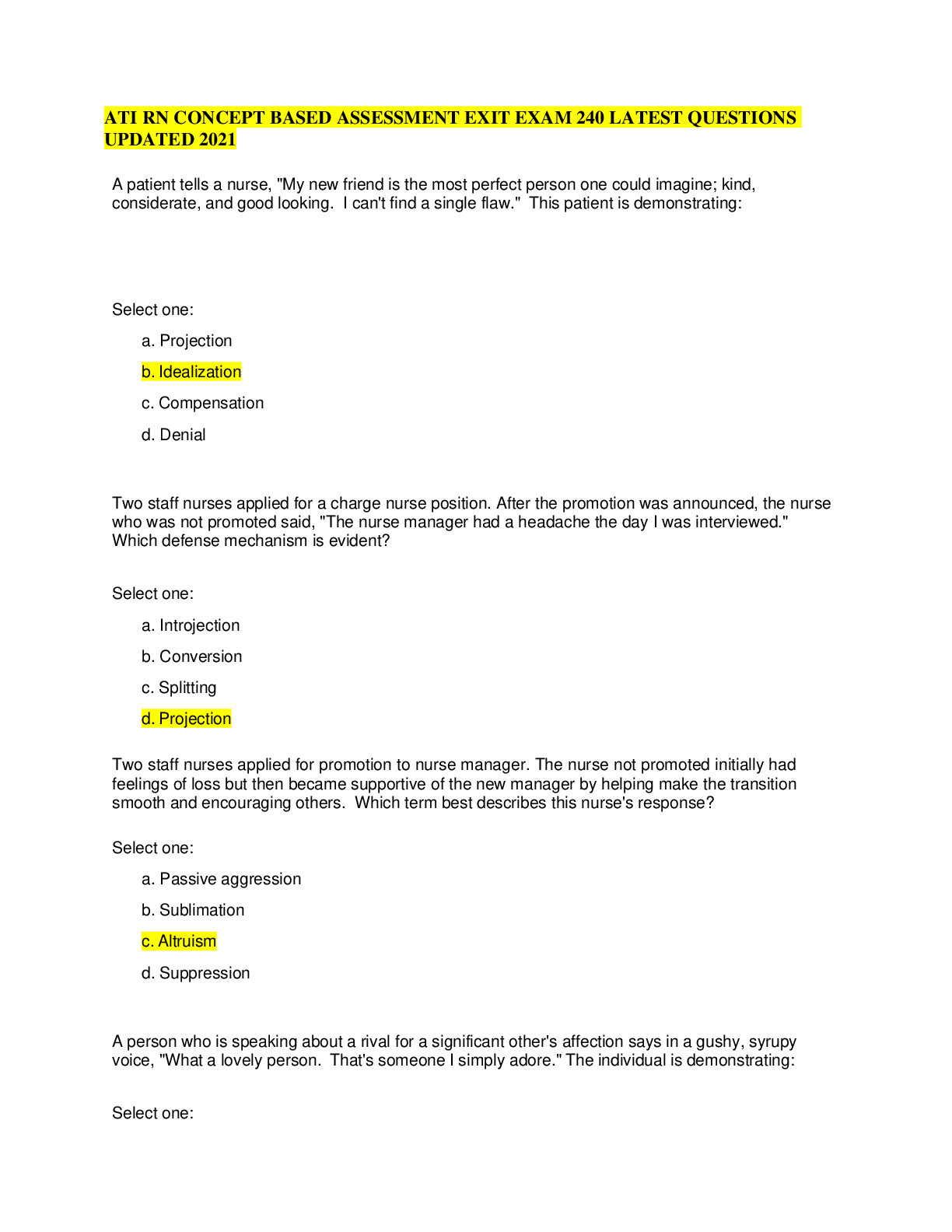*NURSING > QUESTIONS and ANSWERS > RN ATI CAPSTONE FUNDAMENTALS FOCUSED REVIEW 2020 (All)
RN ATI CAPSTONE FUNDAMENTALS FOCUSED REVIEW 2020
Document Content and Description Below
Management Care (1) -Integumentary and Peripheral Vascular Systems: Identifying Skin Lesions (Active Learning Template - Basic Concept, RM FUND 9.0 Ch 30) -Equipment used to assess -adequate ligh... ting, gloves, flexible ruler/tape measure, gown or drape to cover pt -Vascular Lesions -Spider Angioma- red center with radiating red legs, up to 2 cm, possibly raised -cherry Angioma- red 1 to 3cm, round and possibly raised -spider vein- bluish, spider shaped or linear up to several inches in size -petechiae/purpura- deep reddish/purple flat petechiae 1-3mm, purpura > 3mm -ecchymosis- purple fading to green or yellow over time, variable in size, flat -hematoma- raised ecchymosis Safety & Infection control (4) -Client Safety: Priority Action in a Fire Emergency (Active Learning Template - Basic Concept, RM FUND 9.0 Ch 12) -Know the location of exits, alarms, fire extinguishers, and oxygen shut-off valves. -Make sure equipment does not block fire doors. -Know the evacuation plan for the unit and the facility. R: Rescue and protect clients in close proximity to the fire by moving them to a safer location. Clients who are ambulatory may walk independently to a safe location. A: Alarm: Activate the facility’s alarm system and then report the fire’s details and location. C: Contain/Confine the fire by closing doors and windows and turning off any sources of oxygen and any electrical devices. Ventilate clients who are on life support with a bag-valve mask. E: Extinguish the fire if possible using the appropriate fire extinguisher -Home Safety: Teaching About Wound Care (Active Learning Template - Basic Concept, RM FUND 9.0 Ch 13) Burns -Test the temperature of formula and bath water. -Place pots on back burner and turn handle away from front of stove. -Supervise the use of faucets. -Keep matches and lighters out of reach. -Cover electrical outlets Play Injury -Teach to not run with candy or objects in mouth. -Remove doors from refrigerators or other potentially confining structures. -Ensure that bikes are the appropriate size for child. -Teach playground safety. -Teach to play in safe areas, and avoid heavy machinery, railroad tracks, excavation areas, quarries, trunks, and vacant buildings. -Teach to never swim alone and to wear a life jacket in boats. -Wear protective helmets and knee and elbow pads, when needed. -Teach to avoid strangers and keep parents informed of strangers. -Medical and Surgical Asepsis: Maintaining Surgical Asepsis While Performing a Sterile Dressing Change (Active Learning T-template - Nursing Skill, RM FUND 9.0 Ch 10) -The outer wrappings and 1-inch edges of packaging that contains sterile items are not sterile. ---The inner surface of the sterile drape or kit, except for that 1-inch border around the edges, is the sterile field to which other sterile items may be added. -To position the field on the table surface, grasp the 1-inch border before donning sterile gloves. Discard any object that comes into contact with the 1-inch border. -Touch sterile materials only with sterile gloves. -Consider any object held below the waist or above the chest contaminated. -Sterile materials may touch other sterile surfaces or materials; however, contact with nonsterile materials at any time contaminates a sterile area, no matter how short the contact. -Mobility and Immobility: Teaching Correct Use of a Cane (Active Learning Template - Nursing Skill, RM FUND 9.0 Ch 40) -Maintain two points of support on the ground at all times. -Keep the cane on the stronger side of the body. -Support body weight on both legs. -Move the cane forward 15 to cm (6 to 10 inches). -Then move the weaker leg forward toward the cane. -Next, advance the stronger leg past the can Health Promotion and Maintenance - (5) -Health Promotion and Disease Prevention: Teaching About Tertiary Prevention Programs (Active Learning Template - Basic Concept, RM FUND 9.0 Ch 16) -Tertiary prevention aims to prevent the long-term consequences of a chronic illness or disability and to support optimal functioning. -Begins after an injury or illness -Prevention of pressure ulcers after spinal cord injury -Promoting independence after traumatic brain injury -Referrals to support groups -Rehabilitation center Infants (2 Days to 1 Year): Expected Findings for a Newborn (Active Learning Template - Growth and Development, RM FUND 9.0 Ch 18) -Posterior fontanel closes by 2 to 3 months of age. -Anterior fontanel closes by 12 to 18 months of age. -Birth weight should double by 4 to 6 months and triple by the end of the first year. -Infants grow about 2.5 cm (1 in) per month in the first 6 months, and then about 1.25 cm (0.5 in) per month until the end of the first year. -Head circumference increases about 1.25 cm (0.5 in) per month in the first 6 months and then about 0.5 cm (0.2 in) between 6 and 12 months. -Six to eight teeth erupt in the infant’s mouth by the end of the first year. -Use cold teething rings, over-the-counter teething gels, and acetaminophen or ibuprofen. -Use a cool, wet washcloth to clean the teeth. -Do not give infants a bottle when they are falling asleep. Prolonged exposure to milk or juice can cause dental caries (bottle-mouth caries) Infants (2 Days to 1 Year): Providing Nutritional Teaching to the Parent of an Infant (Active Learning Template - Basic Concept, RM FUND 9.0 Ch 18) -Breastfeeding provides optimal nutrition during the first 12 months. Feeding alternatives -Iron-fortified formula is an acceptable alternative to breast milk. -Cow’s milk is inadequate and should not be given before 1 year of age. -Weaning from the breast or bottle can begin when infants can drink from a cup (after 6 months). -Replace a single bottle- or breast-feeding with breast milk or formula in a cup. -Every few days, replace another feeding with a cup. -Replace the bedtime feeding last. -Solid food is appropriate around 4 to 6 months. -Indicators for readiness include voluntary control of the head and trunk and disappearance of the extrusion reflex (pushing food out of the mouth). -Introduce iron-fortified rice cereal first. -Start new foods one at a time over a 5- to 7-day period to observe for signs of allergy or intolerance (fussiness, rash, vomiting, diarrhea, constipation). Vegetables, fruits, and meats follow, generally in that order. Middle Adults (35 to 65 Years): Psychosocial Tasks for a Middle Adult Client (Active Learning Template - Growth and Development, RM FUND 9.0 Ch 24) According to Erikson, middle adults must achieve generativity vs. stagnation. Middle adults strive for generativity Use life as an opportunity for creativity and productivity. Have concern for others. Consider parenting an important task. Contribute to the well-being of the next generation. Strive to do well in one’s own environment. Adjust to changes in physical appearance and abilities.Moral development [Show More]
Last updated: 2 years ago
Preview 1 out of 11 pages

Buy this document to get the full access instantly
Instant Download Access after purchase
Buy NowInstant download
We Accept:

Reviews( 0 )
$9.50
Can't find what you want? Try our AI powered Search
Document information
Connected school, study & course
About the document
Uploaded On
May 25, 2021
Number of pages
11
Written in
Additional information
This document has been written for:
Uploaded
May 25, 2021
Downloads
0
Views
86












